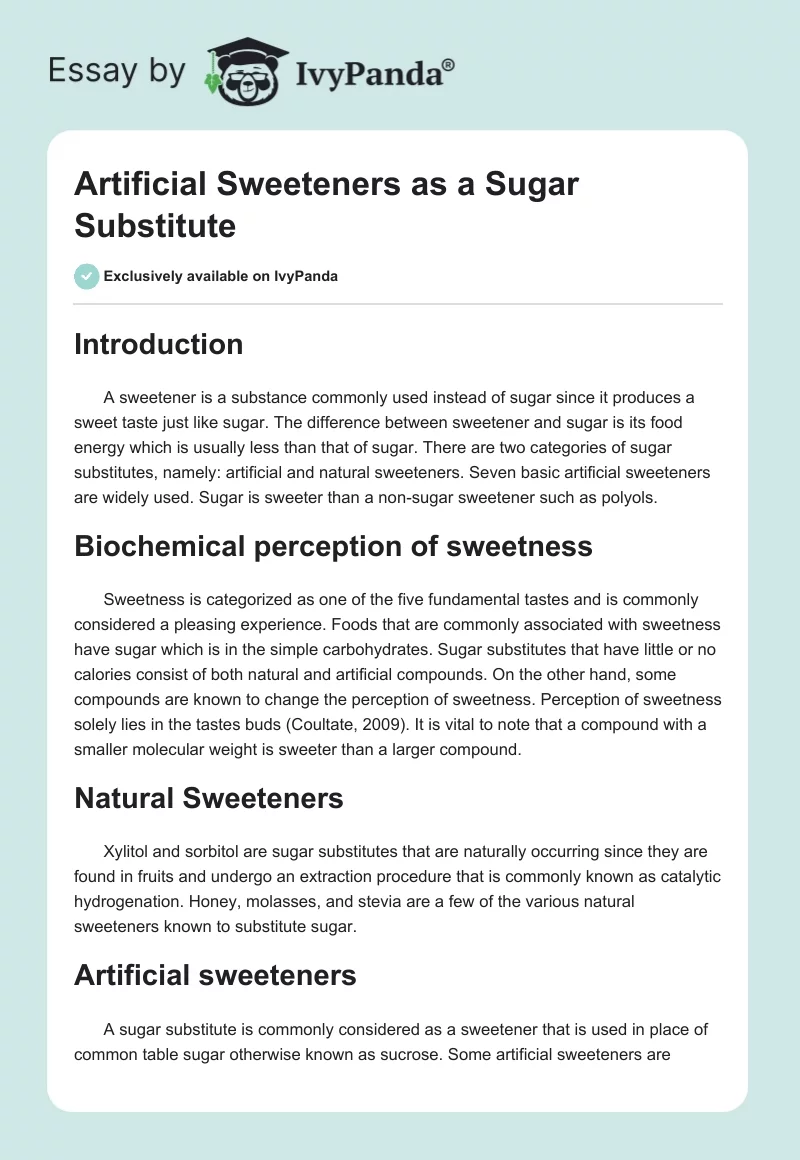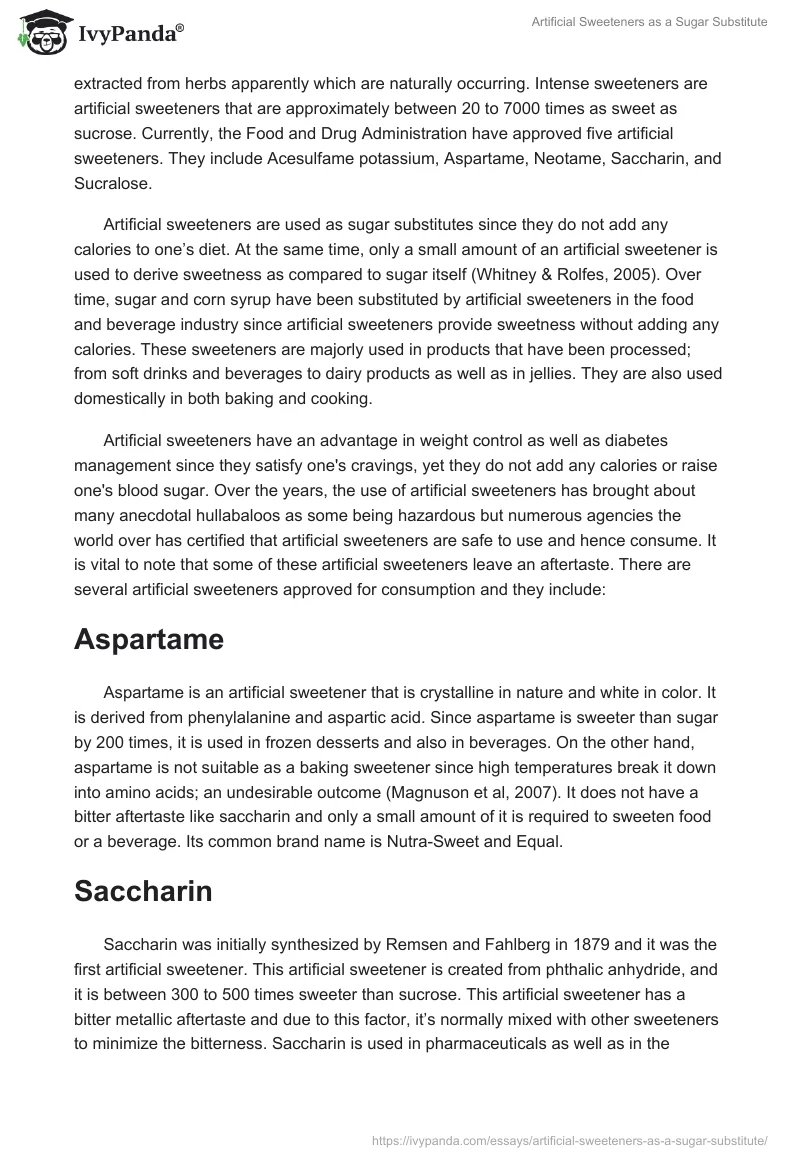Introduction
A sweetener is a substance commonly used instead of sugar since it produces a sweet taste just like sugar. The difference between sweetener and sugar is its food energy which is usually less than that of sugar. There are two categories of sugar substitutes, namely: artificial and natural sweeteners. Seven basic artificial sweeteners are widely used. Sugar is sweeter than a non-sugar sweetener such as polyols.
Biochemical perception of sweetness
Sweetness is categorized as one of the five fundamental tastes and is commonly considered a pleasing experience. Foods that are commonly associated with sweetness have sugar which is in the simple carbohydrates. Sugar substitutes that have little or no calories consist of both natural and artificial compounds. On the other hand, some compounds are known to change the perception of sweetness. Perception of sweetness solely lies in the tastes buds (Coultate, 2009). It is vital to note that a compound with a smaller molecular weight is sweeter than a larger compound.
Natural Sweeteners
Xylitol and sorbitol are sugar substitutes that are naturally occurring since they are found in fruits and undergo an extraction procedure that is commonly known as catalytic hydrogenation. Honey, molasses, and stevia are a few of the various natural sweeteners known to substitute sugar.
Artificial sweeteners
A sugar substitute is commonly considered as a sweetener that is used in place of common table sugar otherwise known as sucrose. Some artificial sweeteners are extracted from herbs apparently which are naturally occurring. Intense sweeteners are artificial sweeteners that are approximately between 20 to 7000 times as sweet as sucrose. Currently, the Food and Drug Administration have approved five artificial sweeteners. They include Acesulfame potassium, Aspartame, Neotame, Saccharin, and Sucralose.
Artificial sweeteners are used as sugar substitutes since they do not add any calories to one’s diet. At the same time, only a small amount of an artificial sweetener is used to derive sweetness as compared to sugar itself (Whitney & Rolfes, 2005). Over time, sugar and corn syrup have been substituted by artificial sweeteners in the food and beverage industry since artificial sweeteners provide sweetness without adding any calories. These sweeteners are majorly used in products that have been processed; from soft drinks and beverages to dairy products as well as in jellies. They are also used domestically in both baking and cooking.
Artificial sweeteners have an advantage in weight control as well as diabetes management since they satisfy one’s cravings, yet they do not add any calories or raise one’s blood sugar. Over the years, the use of artificial sweeteners has brought about many anecdotal hullabaloos as some being hazardous but numerous agencies the world over has certified that artificial sweeteners are safe to use and hence consume. It is vital to note that some of these artificial sweeteners leave an aftertaste. There are several artificial sweeteners approved for consumption and they include:
Aspartame
Aspartame is an artificial sweetener that is crystalline in nature and white in color. It is derived from phenylalanine and aspartic acid. Since aspartame is sweeter than sugar by 200 times, it is used in frozen desserts and also in beverages. On the other hand, aspartame is not suitable as a baking sweetener since high temperatures break it down into amino acids; an undesirable outcome (Magnuson et al, 2007). It does not have a bitter aftertaste like saccharin and only a small amount of it is required to sweeten food or a beverage. Its common brand name is Nutra-Sweet and Equal.
Saccharin
Saccharin was initially synthesized by Remsen and Fahlberg in 1879 and it was the first artificial sweetener. This artificial sweetener is created from phthalic anhydride, and it is between 300 to 500 times sweeter than sucrose. This artificial sweetener has a bitter metallic aftertaste and due to this factor, it’s normally mixed with other sweeteners to minimize the bitterness. Saccharin is used in pharmaceuticals as well as in the manufacture of cosmetics and also in improving the overall taste of toothpaste. It’s popularly known as Sweet and Low.
Sucralose
Sucralose is an artificial sweetener that has three hydroxyl groups instead of its initial chlorine atoms. It is 600 times sweeter than sugar and is commonly used in a variety of products such as chewing gum, beverages, and also frozen desserts. Unlike aspartame, sucralose is stable and when subjected to high temperatures, it does not break down; this makes it suitable in baked as well as fried foods. The human body absorbs about 15 percent of sucralose ingested into the body. Sucralose, which is a chlorinated sugar, has sweeteners such as Splenda and Sukrana.
Acesulfame potassium
Acesulfame potassium is an artificial sweetener that is calorie-free and is a white crystalline powder. It is sweeter than sucrose by 200 times more and it leaves a slightly bitter aftertaste. In a bid to mask this bitter aftertaste, acesulfame potassium is blended with sweeteners such as sucralose and aspartame hence a sugary taste is obtained. And like sucralose, acesulfame potassium is stable in high temperatures as well as alkaline and acidic conditions hence it is widely used in baked food products. Also known as Acesulfame K, it is often blended with other sweeteners and added to make carbonated beverages. It is used in protein shakers as well as in pharmaceutical products as a sweetener. Acesulfame K is generally known and marketed as Sunset and Sweet One.
Neotame
Neotame is an artificial sweetener that is 8000 times sweeter than sucrose. It contains phenylalanine apparently which is never released during digestion. It is stable even under extreme temperatures hence it is used in baked foods. And just like the other artificial sweeteners, neotame has a bitter aftertaste.
Health benefits of artificial sweeteners
Artificial sweeteners have a couple of health benefits to their consumers such as weight control. These sweeteners control one’s weight since they virtually have no calories hence they are non-nutritive (Mattes & Popkin, 2009). It is therefore advisable for persons with the intent of losing weight to use artificial sweeteners as sugar substitutes instead of using high-calorie table sugar.
Artificial sweeteners are a good sugar substitute particularly for persons with diabetes. Artificial sweeteners have no calories like sugar hence they do not raise the levels of blood sugar in a diabetic patient’s body hence it is advisable for a diabetic patient to use artificial sweeteners as a sugar substitute. This mainly applies to persons suffering from diabetes mellitus.
Lastly, continuous consumption of sugar may result in dental cavities in the case where an individual does not take good care of his/her teeth. The occurrence of dental cavities is greatly reduced in the case where the sugar consumed is substituted by artificial sweeteners such as saccharin since it prevents dental cavities.
Health issues caused by artificial sweeteners
There are health concerns that have emerged due to the use of some artificial sweeteners. For instance, the use of saccharin has been associated to cause cancer. Studies carried out during the 1970s demonstrated that indeed saccharin caused bladder cancer in laboratory rats (Swithers & Davidson, 2008). However, this fact is different by the National Cancer Institute as well as health agencies as to there is not adequate evidence to prove that any of the artificial sweeteners cause cancer.
The sweetener aspartame is considered to be the most toxic and harmful to one’s health specially if taken in large quantities. There are fears that aspartame may cause a nervous breakdown, genetic alterations as well as cause more harm than good to the immune system. These health damages are caused by formaldehyde which is aspartame’s metabolite. Even at low levels, formaldehyde is prone to cause quite relentless health issues.
Legal issues associated with artificial sweeteners
Due to the speculations surrounding some of the artificial sweeteners such as aspartame, it is being claimed to cause cancer, lawsuits were prepared against Monsanto and Ajinomoto who are the previous and current manufacturers respectively. In the 1960s aspartame had been realized to have toxic chemicals and it was paradoxically eliminated from the market even after Searle aspartame producing company had tested and it had been approved for limited use. The Food and Drugs Administration had asked the grand jury to investigate aspartame. Later on, after a series of controversies, the sweetener was approved into the market.
Reference List
Coultate Taylor. (2009). Food: The chemistry of its components. Cambridge, UK: The Royal Society of chemistry.
Magnuson Anderson et al. (2007). Aspartame: a safety evaluation based on current use levels, regulations, and toxicological and epidemiological studies. Toxicol 37 (8): 629–727.
Mattes Dilan and Popkin Mase. (2009). Nonnutritive sweetener consumption in humans: effects on appetite and food intake and their putative mechanisms. The American Journal of Clinical Nutrition 89(1), 1-14.
Swithers Simons and Davidson Lee. (2008). A role for sweet taste: calorie predictive relations in energy regulation by rats. Behav Neurosci 122 (1): 161–73.
Whitney Nelson and Rolfes Reney. (2005). Understanding Nutrition. Thomson/Wadsworth Publishing Co: Belmont, CA.


